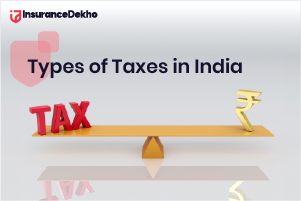Section 80CCC - Understanding Income Tax Deductions on Pension Fund Contributions
Updated On Jan 30, 2024
Understanding various sections of the Income Tax Act is crucial for maximising benefits and optimising tax liabilities. One such section that merits attention, especially for those planning their retirement, is Section 80CCC. This section plays a significant role in financial planning by offering tax deductions for certain pension investments. Through this guide, we aim to shed light on what Section 80CCC entails, its significance, and how it can be utilised effectively in your tax planning strategy.
Table of Contents
What is 80CCC?
Section 80CCC of the Income Tax Act, 1961, pertains to tax deductions on contributions made to certain pension funds. This section is particularly relevant for individuals who invest in pension plans offered by insurance companies. Here's a breakdown of what 80CCC involves:
- Eligibility for Deduction: The deduction under Section 80CCC is available to individuals (not HUFs or other types of taxpayers) who make contributions to certain pension funds. These funds are typically those approved by the Insurance Regulatory and Development Authority of India (IRDAI).
- Nature of Investment: The investment can be in the form of a purchase or contribution to annuity plans, primarily pension plans, provided by life insurance companies.
- Limit of Deduction: The maximum deduction that can be claimed under Section 80CCC is capped at ₹1.5 lakh per annum. This limit is inclusive of the overall cap of ₹1.5 lakh under Sections 80C, 80CCC, and 80CCD(1).
- Taxability of Pension Received: While the contribution to the pension fund is deductible, any pension amount or lump sum withdrawal received in the future is taxable in the hands of the individual.
- Purpose of the Deduction: This section encourages individuals to plan for their retirement by investing in pension schemes, providing tax incentives for doing so.
Understanding Section 80CCC is essential for individuals who are looking at pension schemes not just as a retirement tool but also as a tax-saving instrument.
Terms and Conditions of Section 80CCC
To avail of the tax benefits under Section 80CCC, there are specific terms and conditions that individuals need to be aware of. These include:
- Type of Investor: The deduction is available only to individual taxpayers. Hindu Undivided Families (HUFs) or other entity types are not eligible.
- Approved Pension Funds: The pension fund or annuity plan must be approved by the Insurance Regulatory and Development Authority of India (IRDAI).
- Contribution Limit: The maximum deduction limit is ₹1.5 lakh per annum. This limit is inclusive of the ₹1.5 lakh limit under Sections 80C, 80CCC, and 80CCD(1).
- Nature of Contribution: The deduction is applicable on payments made towards annuity or pension plans, which may include premiums for such plans.
- Taxability on Maturity: The pension received from the annuity plan or the amount received upon surrender of the plan is taxable in the year of receipt.
- Mode of Payment: The contributions must be made via cheque or a banking channel. Cash payments are not eligible for deductions under this section.
- No Double Deduction: The same amount cannot be claimed as a deduction under any other section of the Income Tax Act.
What is Section 10 (23AAB) of the Income Tax Act?
Section 10 (23AAB) of the Income Tax Act, 1961, is closely related to Section 80CCC in the context of pension funds. Here’s what it entails:
- Exemption for Pension Funds: Section 10 (23AAB) provides an exemption for income in the form of contributions or gains made by the pension funds.
- Eligibility: To qualify for this exemption, the fund must be set up by the insurer and approved by the IRDAI.
- Tax Benefit for Insurers: This section essentially offers tax benefits to the pension funds themselves (not directly to the individual contributors), as it exempts their income from tax. This benefit is crucial for maintaining the fiscal viability of pension plans.
- Impact on Investors: While this section does not directly impact individual taxpayers, it supports the overall health and attractiveness of pension schemes in which individuals invest.
Understanding Section 10 (23AAB) is important as it complements Section 80CCC, offering a complete picture of the tax treatment of pension funds in India.
Eligibility for Deduction Under Section 80CCC
To take advantage of the deductions under Section 80CCC of the Income Tax Act, it's essential to understand the eligibility criteria:
- Individual Taxpayers: The deduction under Section 80CCC is available exclusively to individual taxpayers. This means that Hindu Undivided Families (HUFs) or companies cannot claim this deduction.
- Type of Investment: The deduction is applicable for contributions made to specific pension funds. These funds must be pension schemes of insurance companies and must be approved by the Insurance Regulatory and Development Authority of India (IRDAI).
- Mode of Payment: The contributions should be made in non-cash modes, such as cheque, demand draft, or online transfers. Cash payments are not eligible for the deduction under Section 80CCC.
- Resident Status: Both resident and non-resident Indians are eligible for this deduction.
- Age Limit: There is no specific age limit for availing of this deduction as long as the contribution is made to eligible pension funds.
Important Points Related to Section 80CCC
Understanding some key aspects of Section 80CCC can help in effective tax planning:
- Combined Deduction Limit: The maximum limit of deduction under Section 80CCC is ₹1.5 lakh per financial year. This limit is inclusive of the deductions available under Sections 80C, 80CCC, and 80CCD(1).
- Taxation of Pension Received: It’s important to note that while the contributions to the pension fund are deductible, the pension received from such a fund is taxable as income. Similarly, any lump-sum withdrawal from the fund is also taxable.
- No Double Benefit: Contributions claimed under Section 80CCC cannot be claimed as a deduction under any other provision of the Income Tax Act.
- Proof of Investment: To claim the deduction, you must have valid proof of investment, such as a receipt or a statement from the insurance company.
- Continuity of Deduction: The deduction is available each year as long as contributions are made to the pension fund. This encourages continuous investment in pension plans.
Understanding these aspects of Section 80CCC ensures that individuals make informed decisions about their retirement planning and tax-saving strategies.
Comparing Sections 80C, 80CCC, and 80CCD(1).
|
Feature/Section |
Section 80C |
Section 80CCC |
Section 80CCD(1) |
|
Type of Investment/Payment |
Includes a wide range of investments like EPF, PPF, NSC, ELSS, life insurance premiums, tuition fees, principal repayment of home loan, etc. |
Pertains exclusively to payments made to annuity plans of LIC or other insurers for receiving pension. |
Contributions to the National Pension System (NPS) and Atal Pension Yojana (APY). |
|
Maximum Deduction Limit |
Up to ₹1,50,000 per financial year. |
Up to ₹1,50,000 per financial year. However, this is within the overall limit of Section 80C. |
Up to 10% of salary (for salaried individuals) or 20% of gross total income (for self-employed) or ₹1,50,000, whichever is less. This is within the overall limit of ₹1,50,000 under Section 80CCE. |
|
Eligibility |
Individuals and HUFs. |
Individuals who have purchased annuity plans. |
All individuals, both salaried and self-employed. |
|
Specific Conditions or Features |
Includes various types of investments and expenses. Tax benefit depends on the type of instrument chosen. |
Deduction for the premium paid for annuity plan; pension received in future years is taxable. |
Additional deduction of ₹50,000 is available under Section 80CCD(1B) over and above the ₹1,50,000 limit. The maturity proceeds are partially taxable. |
Conclusion
Section 80CCC of the Income Tax Act plays a pivotal role in encouraging individuals to plan for their retirement while offering the benefit of tax deductions. It underscores the importance of saving for the post-retirement period through pension funds, with the added advantage of reducing taxable income. By understanding the intricacies of Section 80CCC, taxpayers can effectively utilise this provision to enhance their retirement savings while optimising their tax liabilities. As with any financial decision, it is crucial to consider individual retirement needs, investment horizons, and tax implications to make the most of the opportunities presented by such tax-saving instruments.
FAQs
- What is Section 80CCC?
Section 80CCC allows deductions for contributions made to certain pension funds by individual taxpayers.
- Who is eligible for deductions under Section 80CCC?
Any individual taxpayer who contributes to specified pension funds is eligible, but HUFs and companies are not.
- What is the maximum deduction limit under Section 80CCC?
The maximum deduction limit is ₹1.5 lakh per annum, which is inclusive of the limits under Sections 80C, 80CCC, and 80CCD(1).
- Are the contributions made in cash eligible for deduction?
No, contributions made in cash are not eligible for deduction under Section 80CCC. Payments should be made via non-cash modes.
- Is the pension received from these funds taxable?
Yes, the pension received or any lump sum withdrawal from these funds is taxable.
- Can NRIs claim deductions under Section 80CCC?
Yes, both resident and non-resident Indians are eligible for this deduction.
- Are there any age restrictions for availing of Section 80CCC benefits?
There are no specific age restrictions for availing of the benefits under Section 80CCC.
- Can I claim a deduction under Section 80CCC for a pension fund and another deduction under Section 80C?
Yes, but the combined limit under Sections 80C, 80CCC, and 80CCD(1) is capped at ₹1.5 lakh.
- What kinds of pension funds qualify for Section 80CCC deductions?
Only pension funds that are approved by the IRDAI and provided by insurance companies qualify.
- Do I need to provide any proof for claiming this deduction?
Yes, you should have valid proof of investment such as receipts or statements from the insurance company.



























